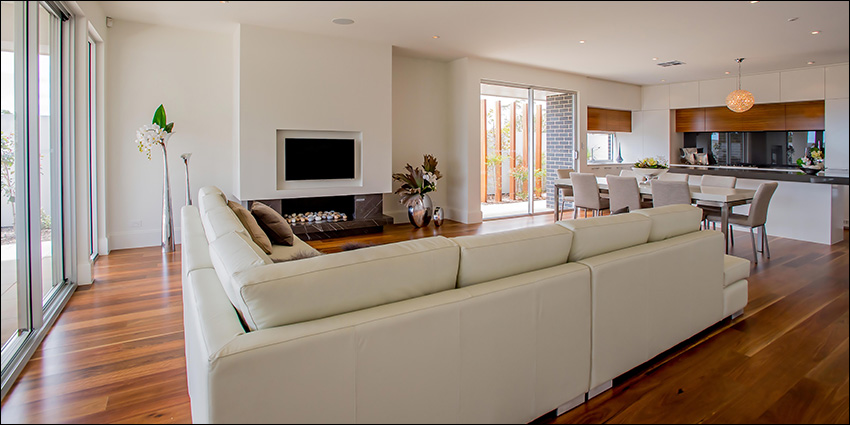For millions of people who are now working from home, the most sought-after feature is not open-plan living. It’s a dedicated workspace with a door that can be closed.
Many large and small businesses have said that working remotely will now become the norm. It saves companies money on overheads and most bosses have been surprised to discover during lockdown that workers’ productivity generally increased, not declined.
Many workers who’ve had a taste of it say they prefer it too. No more having to spend time and money commuting to work each day in rush-hour traffic. More time to spend with loved ones or pursuing hobbies. Some can even choose their own work hours. It’s a quality of life that most people could only dream of before. What’s not to like?
The problem with open-plan design
Well, it’s fine if you live alone or have a dedicated workspace in your home or a spare bedroom you can repurpose as your home office. You can close the door when you’re working and get the quiet and seclusion you need.
But what if your home is designed for open plan living and suddenly you’re trying to work in the same space that your partner and kids also use? Suddenly, it doesn’t seem like such a good idea anymore.
Open plan design has largely been accepted as modern and cool, but readers of my blog will know I’ve never been a fan. A combined kitchen and dining area can make sense. The problems start when you add in a living area too. I’ve seen too many families struggling to find peace and privacy in such homes. Worst of all are the homes with wooden or tiled floors and no rugs or curtains to muffle the sound. ‘Driven to the brink of madness’, is a phrase I’ve often heard from parents living with young children in such places.
Open plan during lockdown
The appeal of open plan design is that it combines small areas into one large room. It makes the space seem bigger than it is. We rented an apartment like this for two weeks after we moved from Australia to the UK earlier this year. It had an open-plan kitchen, dining room and lounge, and felt like a great place to kick back while house hunting.
Then lockdown happened, house hunting was put on hold, and two weeks turned into twenty. Never again.
I had always planned to spend the early part of this year writing, so I set up a little desk in the corner of the bedroom and hunkered down. That left the dining room table as the only place Richard could do Clutter Clearing and Personal Insight video calls with clients, which meant I could only use the kitchen and lounge in between calls. We managed, but it was far from ideal. I’m sure there are many people reading this who know exactly how this feels.
If you own your own home, it may have crossed your mind to convert open plan to broken plan by putting up partitions. But the difficulty with that (apart from the expense) is that the resulting room sizes may be claustrophobically small and some may not have natural daylight. It’s a huge problem that no one ever expected to have and there’s no easy solution.
Decluttering and additional storage can help
A messy or cluttered environment makes spaces seem even smaller and makes everything harder work. If your home was already loaded with clutter before the pandemic and now you have work-related things you need to keep there too, it can make the situation worse.
Keeping things stored out of sight can at least reduce visual clutter. But beware of double stacking, with one row at the front and a row of things stacked behind. Having to constantly move things to be able to get to the items behind them can translate into your life as having to put in more effort to achieve anything you want to do. It can feel tiring and frustrating.
The best strategy is to have a good clear-out and let go of the things you no longer need. If that’s not an option, then invest in extra storage. If your lounge or dining room is now your home office then you may have to resign yourself to it looking more officey.
Ultimately, if working remotely has become a way of life for you, you may need to think about moving to a home that will facilitate that. And do that sooner rather than later because lots of people are sure to have the same idea.
Copyright © Clear Space Living Ltd, 2020
Related articles
The delights and idiocies of open-plan design
Working from home: A guide to creating a healthy and productive workspace at home
Like to read more articles like this?
Subscribe to my newsletters to receive news, articles and information about upcoming online courses by email. And I promise you – no junk mail ever.





Totally agree with you, these “Flipping House” shows knock out every wall they can. I think of structural problems later on with events such as storms and earthquakes. Also if you have a pet, the open kitchen concept is not very hygienic, especially with cats who hop up on everything. I think it is cheaper for builder’s to construct houses this way, just one big box as the center of home. I like partial open kitchen, where you are not afraid to cook in it fearing it will make the whole living area look messy. Try cooking quietly, while others watch TV haha! Do we have to have no walls so others might help prepare food? Ridiculous.